All About Dehydrated Vegetables
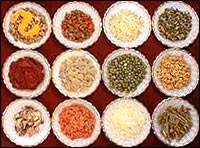 Introduction
Introduction
Green Beans
Broccoli
Cabbage
Carrots
Celery
Sweet Corn
Mushrooms
Onions
Sweet Garden Peas
Hash Browns
Tomato Powder
Introduction
Dehydration techniques have come a long way in recent years. Old technology left as much as 30% moisture in the dehydrated products. Nor did these poorly dehydrated foods store very well. With present technology, moisture levels have been reduced to 2% or 3%. Gone are the pliable dehydrated foods. Now they break with a crisp "snap" when bent. With moisture levels reduced to 2%-3%, storage life has been increased to several years. In doing background work for this study, I opened up a can of dehydrated carrots and another can of onions that were 8 years old. They had each been stored for at least 3 of those years in a warm garage. During the last five years they were in our basement food storage room. During a careful taste test I could not tell the difference between the items 8 years old and the freshly dehydrated carrots and onions. Next, I opened a can of potato flakes we've had in our food storage for the last 15 years. This can of potato flakes has followed us around for what seems like numberless apartments and homes, sometimes stored well and sometimes not. How did they taste? Really nice and fresh.
Five years ago we obtained several 28 year old cans of dehydrated food that had been stored unusually cool. Then we ask the Benson Institute at BYU to test them. The results of the test were most positive for such old food. These cans have been sitting in our manager, Mr. Portela's basement since that time. Having had the opportunity to taste them myself recently, even after 5 years of being stored in open cans covered with plastic lids, these foods are still maintaining their quality. I find this remarkable - even amazing. What makes this all the more interesting is that none of these cans in Mr. Portela's basement or my food storage room were stored with oxygen absorbers. Things like this make me think we've under-rated the storage life of many of our dry-pack canned foods on our Storage Life Of Foods Page. This is now especially true considering our cans contain only minimal oxygen. For those of you new to this concept, removing the oxidizing oxygen is one of the key factors in extending the life of dehydrated foods.
Flavor: Don't expect dehydrated vegetables to taste exactly like their fresh or canned counterparts. For example, I think back to when my children were really small. They were used to eating canned peas. Then one day we boiled up some fresh peas straight from our new garden and served them at dinner. After one taste, two of the kids who were less than 8 years old and had never tasted fresh cooked peas before said, "Uuooo, I don't like this." The peas didn't taste exactly like what they were accustomed to, even though they had what most people consider a better flavor. In a similar way, some people will say, "Uuooo, I don't like that," when tasting dehydrated foods for the first time because of a slightly different taste. Just like my little kids' first experience with the fresh garden peas, it's not a bad taste, just a little different taste. Generally speaking, dehydrated foods won't have quite as strong a flavor as fresh foods. Almost in every case, however, after adding a little butter and salt and pepper, prepared, dehydrated food is every bit as tasty and sometimes even better tasting than canned vegetables.
Opened Cans: Often people ask, "Don't I need to keep these foods in the refrigerator after opening them?" Folks who haven't used dehydrated foods before have learned to accept without question the necessity of putting their wet-packed foods in the refrigerator after opening them. Of course, this is very important for wet packed foods as they will spoil if you don't. But dehydrated food is different. It takes a moisture content of 15% to 30% for most molds or bacteria to begin growing. The moisture content of these dehydrated foods falls far below this, and should not be a concern unless you live in a humid environment.
What should you be concerned about regarding the dehydrated foods you have in opened cans? Be careful of storage conditions in overly high temperatures and high humidities. All our cans come with a plastic lid to close them after removing the metal lid with a can opener. Although these lids are not air tight, if you live in a dry climate, they do provide enough protection to keep your dehydrated foods fresh for a while. However, if you live in a humid area or think it will take you several months to use up the contents, we suggest putting the food into a different container after opening the can. Here's the problem... as the barometric air pressure rises and falls, it pushes and pulls air into and out of your opened cans around the plastic lid. As it does this it will bring in moisture with it that's absorbed into the food. When enough moisture has been absorbed that the food becomes pliable, the storage life has been seriously degraded and you need to use it up. If you wish to be a bit cautious, when you open a can, transfer it's contents into other air tight containers. A good piece of Tupperware has a better sealing lid than the plastic lid that comes on our cans. But perhaps the best solution is to put your food in Zip-lock bags. As they have flexible walls, they can bend with the air pressure changes so there's never a difference of pressure between the inside and the outside of the bag wall, such as what you do find with rigid walled containers. With your food in baggies, you can throw them right back into the #10 can the food came out of and put the included plastic lid back on the top.
We are also ask, "Don't I need to put more oxygen absorbers into the can after opening it?" No, it's not necessary. These foods aren't fragile but can take a certain amount of abuse before their nutritional or taste qualities deteriorate very much. Right now in my family's pantry in the kitchen, we have several #10 cans that are partly full, some of them having been open for several months. In every instance, the foods are still completely serviceable. Granted, we live in a dry, cool climate, ideal for dehydrated food storage.
Low Weight: The dehydrated vegetables in this study increased in weight when rehydrated from 3 1/4 times to 6 times depending on the food. This decreased weight can mean a lot depending on your circumstances, especially if they must be carried or shipped.
Low volume: Except for the mushrooms, the foods in the study increased in volume 2 to 3.5 times when they were rehydrated. It's amazing how many cans of wet packed vegetables it takes to equal the amount of food that's in a #10 can. In most #303 sized cans of vegetables, after the water is drained off, there remains about 1 cup of food. Erring on the side of using too much dehydrated food in this comparison, if 1/2 cup of dehydrated food is required to equal the actual food in a #303 can, that #10 can would hold the equivalent of 27 #303 cans of wet-packed food. Which would you rather have in your pantry? One #10 can or over a case of #303 cans?
Preparation time/technique: Yes, it does take a bit more time to prepare dehydrated food. However, it doesn't take that much more time. And sometimes the dehydrated foods can be more quickly prepared than fresh foods. Take our hashbrowns for example. They can be ready for the frying pan in just 10 minutes. If I'm working with unpeeled potatoes it takes me longer than this. On the other end of the spectrum, our dehydrated sweet corn takes about the longest time to rehydrate - a cooking time of about 1/2 hour. Most meals prepared from dehydrated vegetables can be ready to eat from the pantry to the dinner table within 30 minutes. If time isn't a big factor, dehydrated vegetables cook up very nicely in a crock pot. And if you are in a big hurry, they rehydrate quickly in a pressure cooker.
Nutrition: Dehydrated food retains more of it's nutrients than either frozen or canned foods. Please see our Nutrient Loss Comparison Page for specifics.
Waste: With dehydrated foods there's never any waste, unless of course, you don't eat it all. The parts of the plant that are generally trimmed have already been cut off before starting the dehydration procedure. After the dehydration process is complete, all that's left is the best part of the food. And with the dehydrated food, safe in a can in your pantry, you never have to concern yourself with fresh vegetables going bad in the bottom of your refrigerator.
Cost: Lets use sweet garden peas for one example... In December of 2000, a #303 can of peas in the Montpelier, Idaho, grocery store cost 59 cents. After the water was drained, there was about a cup of peas remaining, so they cost about 59 cents per cup. A #10 can of dehydrated sweet garden peas costs $19.30. As these peas rehydrate, they increase in volume 300% of their dry volume, or to about 40 cups. That's equal to about 40 each #303 cans. Yes, dehydrated, all these peas can fit into a #10 can. Rehydrated, the dehydrated sweet peas cost 48 cents a cup, so they are 11 cents cheaper per cup than canned peas.

Can sizes from left to right: #10 can, #2.5 can and a #303 can.
Doing a little further figuring, rehydrated carrots cost about 20 cents per cup (a #303 can costs 59 cents); cabbage, 33 cents a cup (a #303 can of sauerkraut costs 69 cents); tomato paste, 54 cents for a cup or 8oz (a 6oz can in the store costs 59 cents or calculated to 79 cents for 8 oz) and rehydrated mushrooms cost 81 cents a cup (a #303 can costs $1.89). The only vegetables in the study that didn't cost less dehydrated were the rehydrated sweet corn, costing 74 cents per cup (a #303 can in the grocery store cost 59 cents) and green beans costing 65 cents a cup (a #303 can costs 60 cents).
If you bought these foods at our bulk prices in bags or boxes, the cost would only be 30% to 55% of our #10 can prices depending on the food. This reflects costs for dehydrated vegetables far below grocery store prices for canned vegetables!!!
What follows are pictures and a brief description of several of the dehydrated vegetables in this study.
Green Beans

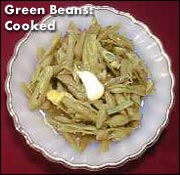 Green Beans increase in volume about 2 times when boiled in water; the weight increases 5 times. Of all the dehydrated foods in this study, the green beans reconstituted more closely to it's canned counterpart. You could put a serving of canned green beans next to a serving of cooked dehydrated green beans and not be able to see the difference.
Green Beans increase in volume about 2 times when boiled in water; the weight increases 5 times. Of all the dehydrated foods in this study, the green beans reconstituted more closely to it's canned counterpart. You could put a serving of canned green beans next to a serving of cooked dehydrated green beans and not be able to see the difference.
The texture and flavor is also very similar. Because of how light dehydrated green beans are, a pound of them would last a typical family for quite a while. Dehydrated green beans go great by themselves but would be equally as tasty in green bean casserole or any other green bean dish.
Broccoli

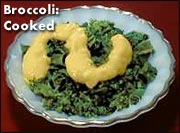 Broccoli increases in volume about 2.25 times when boiled in water; the weight increases 5.4 times. Broccoli can be reconstituted in either cold or hot water and rehydrates in cold water in 10 to 15 minutes. The dried broccoli breaks smartly when bent. It seemed to me that rehydrated, raw broccoli is just a bit more tuff than it's fresh counterpart. Boil it for two minutes and you will be hard pressed to tell it from fresh cooked broccoli that's been shredded a bit.
Broccoli increases in volume about 2.25 times when boiled in water; the weight increases 5.4 times. Broccoli can be reconstituted in either cold or hot water and rehydrates in cold water in 10 to 15 minutes. The dried broccoli breaks smartly when bent. It seemed to me that rehydrated, raw broccoli is just a bit more tuff than it's fresh counterpart. Boil it for two minutes and you will be hard pressed to tell it from fresh cooked broccoli that's been shredded a bit.
Mr. Portela, my boss, makes a broccoli cheese sauce from cheese powder and dehydrated broccoli that will knock your socks off - delicious! You can't buy canned broccoli, but you can surely dehydrate it. And another really BIG plus with dehydrated broccoli - you don't have to cut off the stem - the majority of the weight - and throw it away. Dehydrated broccoli consists of 'just the tops'.
Cabbage

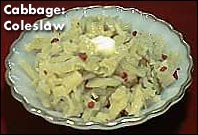 Cabbage increases about 2.25 times when soaked in cold water, when boiled, about 2.6 times; the weight increases 6 times when cooked. After a couple of people told me they've made coleslaw with dehydrated cabbage I had to try this myself. The rehydrated raw cabbage lacks the crispness of fresh, uncooked cabbage but has basically the same flavor. Still, I think it lacks a certain amount of robustness that traditional coleslaw has.
Cabbage increases about 2.25 times when soaked in cold water, when boiled, about 2.6 times; the weight increases 6 times when cooked. After a couple of people told me they've made coleslaw with dehydrated cabbage I had to try this myself. The rehydrated raw cabbage lacks the crispness of fresh, uncooked cabbage but has basically the same flavor. Still, I think it lacks a certain amount of robustness that traditional coleslaw has.
The military has been using dehydrated cabbage in their dining facilities for many years. Boiled, dehydrated cabbage has much of the same taste as fresh cooked cabbage and is one of the more successfully dehydrated foods used in the US food industry.
Carrots

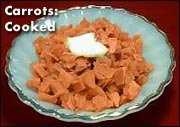 Carrots increase in volume about 3 times when boiled in water; the weight increases 4.6 times. It takes them about 15 minutes to cook. Rehydrated carrots in cold water are not a good substitute for raw carrots.
Carrots increase in volume about 3 times when boiled in water; the weight increases 4.6 times. It takes them about 15 minutes to cook. Rehydrated carrots in cold water are not a good substitute for raw carrots.
However, cooked, with salt and pepper and a bit of butter added they have a nice flavor, as nice, I think, as fresh cooked carrots or canned carrots. Eat them by themselves as cooked carrots or throw a handful of them, dry, into your soups, stews or casseroles before cooking.
Celery

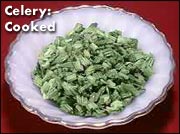 Celery increases in volume about 2 times when soaked in cool water; the weight increases 4.2 times. Me, I really didn't like the raw, reconstituted celery by itself. It wasn't as good as fresh celery as it was a bit harder and didn't have the crispness of fresh celery.
Celery increases in volume about 2 times when soaked in cool water; the weight increases 4.2 times. Me, I really didn't like the raw, reconstituted celery by itself. It wasn't as good as fresh celery as it was a bit harder and didn't have the crispness of fresh celery.
However, in cooked dishes such as stews, soups and poultry stuffing, dehydrated celery's flavor and aroma comes through loud and clear, every bit as good as if you were using fresh celery. You can feel comfortable in using dehydrated celery in any cooked recipe that calls for fresh celery. And it saves time. Instead of having to wash and cut fresh celery, you can simply toss a small handful of dehydrated celery right into the makings of most dishes. ...quick and easy.
Sweet Corn

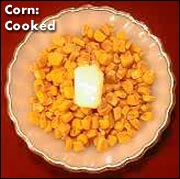 Our Super Sweet Corn increases in volume about 2 times when boiled in water; the weight increases 3.3 times. Their dehydrated color is darker than either fresh or canned corn and even though they do lighten up a bit when rehydrated, they still maintain a darker color than either fresh or canned corn. After cooking for a half hour, the rehydrated, cooked corn is noticeably not as soft as fresh or canned corn.
Our Super Sweet Corn increases in volume about 2 times when boiled in water; the weight increases 3.3 times. Their dehydrated color is darker than either fresh or canned corn and even though they do lighten up a bit when rehydrated, they still maintain a darker color than either fresh or canned corn. After cooking for a half hour, the rehydrated, cooked corn is noticeably not as soft as fresh or canned corn.
Experimenting, I blended up a small amount of the dehydrated corn then boiled it to see if I could make creamed corn. After cooking it for 1/2 hour, it never did thicken up by itself. It's flavor is quite tolerable, although in my opinion, not as good as fresh or canned corn. Yes, like the other dehydrated foods we mentioned thus far, you could toss a handful of dried corn into many different dishes before cooking them and it would add flavor and texture to your dishes.
Valerie Jackson forwarded the following interesting note...
"The pressure cooker is especially good for the corn. If you treat dried corn more like posole, or a quicker cooking legume, you will have great results. I also find corn benefits greatly from soaking for several hours, if you have the time to plan ahead."
Mushrooms

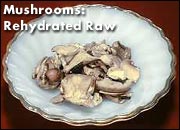 Mushrooms, when rehydrated, remain about the same volume when soaked in cool water; the weight increases 4.1 times. Rehydrated dry mushrooms have basically the same texture and flavor of fresh, raw mushrooms but lack some crispness.
Mushrooms, when rehydrated, remain about the same volume when soaked in cool water; the weight increases 4.1 times. Rehydrated dry mushrooms have basically the same texture and flavor of fresh, raw mushrooms but lack some crispness.
Rehydrated in cold water, I think these mushrooms are good enough to put in dishes that call for raw mushrooms such as green salads. I feel you can use them with confidence in any cooked dish that calls for cooked or fresh mushrooms.
Onions

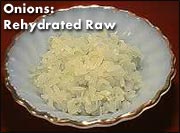 Chopped Onions increase in volume about 1.3 times when soaked in cool water. When boiled, they increase in volume 3 times and the weight increases 4 times. Raw, they aren't quite as good as fresh onions but are certainly good enough to use in place of raw onions in such dishes as potato salad.
Chopped Onions increase in volume about 1.3 times when soaked in cool water. When boiled, they increase in volume 3 times and the weight increases 4 times. Raw, they aren't quite as good as fresh onions but are certainly good enough to use in place of raw onions in such dishes as potato salad.
Cooked in meat loaf, stews or whatever you add onions to, you will not notice any difference between fresh and dehydrated onions. Rehydrated onions, soaked in cool water, look very much like fresh cut onions and can be used interchangeably in most places where fresh onions are used.
Sweet Garden Peas

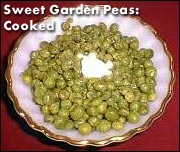 Dehydrated Sweet Garden Peas increase in volume about 3 times when boiled in water; the weight increases about 3.3 times. Eaten plain, their flavor falls somewhere between fresh and canned peas. Their texture is more like fresh cooked peas than canned peas.
Dehydrated Sweet Garden Peas increase in volume about 3 times when boiled in water; the weight increases about 3.3 times. Eaten plain, their flavor falls somewhere between fresh and canned peas. Their texture is more like fresh cooked peas than canned peas.
With salt and pepper and a little butter, it's really hard to distinguish them from fresh peas. These peas also have a really nice color when rehydrated. I don't think you could tell them apart from fresh cooked peas, being darker in color than canned peas.
Mixed Peppers

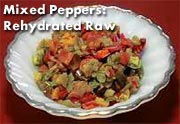 Our Mixed Peppers consist of red and green bell peppers. They increase in volume about 2 times when soaked in cool water; the weight increases 6.1 times. Rehydrated in cold water, the raw peppers have nice color and the flavor is good enough to use in dishes that use uncooked peppers such as the raw salsa that some people like.
Our Mixed Peppers consist of red and green bell peppers. They increase in volume about 2 times when soaked in cool water; the weight increases 6.1 times. Rehydrated in cold water, the raw peppers have nice color and the flavor is good enough to use in dishes that use uncooked peppers such as the raw salsa that some people like.
Not quite as crisp as fresh, cut bell peppers and consisting of much smaller pieces, you may or may not like them in green salads. Cooked in a casserole, soup or stew, I don't think you'd be able to tell the difference between fresh peppers and dehydrated peppers.
Hash Browns

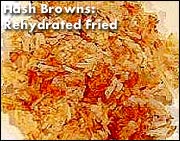 Hashbrowns increase in volume 2.6 times when boiled in water; their weight increases 5.8 times. Dehydrated, they are hard and smartly break when bent. To rehydrate, pour the dehydrated potatoes in 3 parts of boiling water. Let them boil until tender which usually takes about 10 minutes.
Hashbrowns increase in volume 2.6 times when boiled in water; their weight increases 5.8 times. Dehydrated, they are hard and smartly break when bent. To rehydrate, pour the dehydrated potatoes in 3 parts of boiling water. Let them boil until tender which usually takes about 10 minutes.
They will absorb most of the water. Unlike raw, grated potatoes, when you boil these spuds they won't turn into mush. After they are soft, drain whatever water is left in them and throw them in a hot, oiled frying pan. They take more heat than fresh potatoes to brown. If your taste buds are like mine, you'll love these things. In fact, I like them better than hashbrowns the wife makes from fresh, baked potatoes. ...just a delightful flavor and texture.
Tomato Powder

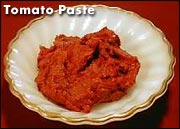 Tomato powder increases in volume about 1.66 times and increases in weight about 2.7 times when making it into a thick tomato paste. Of course, it will stretch further if you wish to make it into tomato sauce - increasing in volume about 2 1/2 times. Adding more water still, I thinned it down to the consistency of tomato juice. It's color was a little darker and had a bit more of a bite than tomato juice - With a couple of shakes of celery salt and a shake of Tabasco Sauce it really kicks!
Tomato powder increases in volume about 1.66 times and increases in weight about 2.7 times when making it into a thick tomato paste. Of course, it will stretch further if you wish to make it into tomato sauce - increasing in volume about 2 1/2 times. Adding more water still, I thinned it down to the consistency of tomato juice. It's color was a little darker and had a bit more of a bite than tomato juice - With a couple of shakes of celery salt and a shake of Tabasco Sauce it really kicks!
Tomato powder is extremely hydrophilic which means it just loves water. In fact, it will absorb moisture right out of the air. I've had more than one person call me and say their tomato powder was ok when they opened it, "but now it's as hard as a rock." This happens when it has absorbed too much moisture. This is not so much of a problem in dry climates, however. The can of tomato powder in my pantry has been open for over a year now and it's still a powder. If you live in a high humidity area, upon opening your can, you may wish to transfer most of it into smaller, airtight containers to prevent this from happening. If it does 'set up' on you, it's still useable. Break a chunk off and put it in water. It'll soften up.
You can add tomato powder in any dish where you'd use tomato paste or tomato sauce. The flavor should be the same and we think you'll be really happy with it.